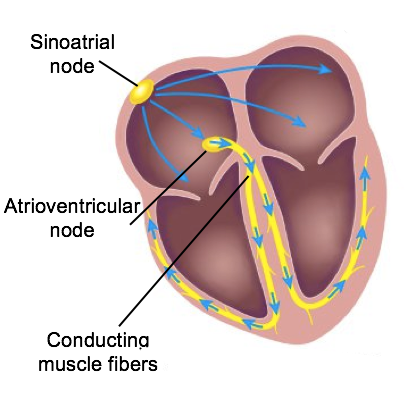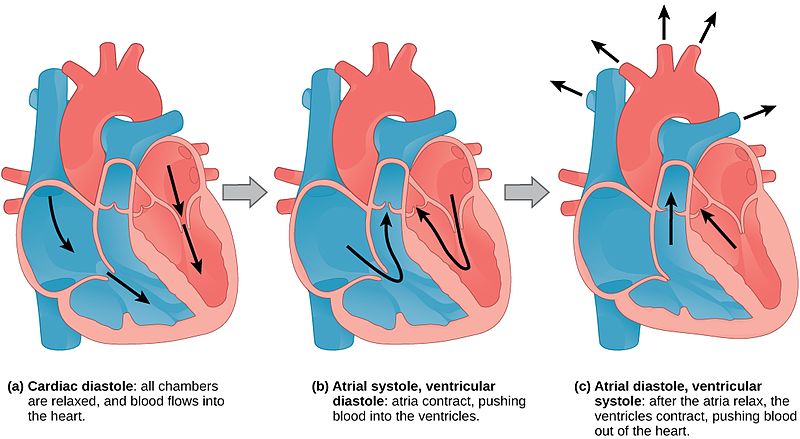Table of Contents |
The cardiac cycle is a sequence of events that occurs when the chambers of our heart contract and relax. We have four chambers in our heart; the right atrium, left atrium, right ventricle, and left ventricle. When these chambers contract and relax, it acts to pump blood throughout the body. This contraction and relaxation occur at the same time on each side of the heart.
EXAMPLE
When the right atrium relaxes, the left atrium relaxes. When the right atrium contracts, the left atrium contracts.The two phases of the cardiac cycle are:
About 1% of the cells of the heart are a part of the cardiac conduction system. This group of cells are self-exciting and produce electrical signals, or electrical impulses, that stimulate heart contractions. They act as a pacemaker and drive our heart contractions. More importantly, they do so independently of the nervous system. This is an interesting fact because, even if all nerves that were leading to the heart were cut, the heart would still be able to beat.
There are two places where a bunch of the specialized cardiac conduction system cells cluster, and these clusters are called nodes. Our heart beats because of the self-exciting cells in the two nodes of the heart.

The sinoatrial node (also known as the SA node) produces an excitation wave that will spread over both of the atria. This signals for contraction and spreads so quickly that the cardiac muscle cells will contract together almost as one unit. When our atria contract, blood flows into our ventricles.
This wave will start to slow down when it reaches our atrioventricular node, which is the second node. The slower conduction in the atrioventricular node is important because it allows for the atria to have time to finish contracting before the wave travels from the atrioventricular node to the ventricles. Once the atria are done contracting and the blood has filled out the ventricles, then the wave will stimulate the ventricles to contract.
Connected to these nodes, we have conducting muscle fibers that spread throughout the atria and the ventricles.
| Process of the Cardiac Cycle | |
|---|---|
| 1. The pacemaker starts the cardiac cycle | The sinoatrial node depolarizes, sending an electrical impulse. |
| 2. Systole begins | The impulse from the SA node causes the atria to contract. This pushes blood into the ventricles. |
| 3. The propagating electrical impulse reaches the gateway | The electrical impulse reaches the AV node and slows. By the time the ventricles are done filling, the electrical impulse will have traveled far enough to cause the ventricles to contract. |
| 4. Systole ends | The right ventricle pushes blood through the pulmonary artery (toward the lungs); this blood enters the pulmonary cycle. Meanwhile, the left ventricle pushes blood through the aorta; this blood enters the systemic cycle. |
| 5. Diastole begins | Because the heart has been emptied of blood, when the muscle relaxes, this creates a negative pressure (the relaxed heart is larger in volume, but has very little blood in it). As a result, blood comes rushing in to relieve the negative pressure. |

When our atria contract, they push blood into the ventricles. The atrioventricular valve (or AV valves) separate the atria from the ventricles and prevent blood from flowing back into the atria once it enters the ventricle. From there, the ventricles are going to contract and, depending on which side of the heart it is, are going to pump blood into the pulmonary artery or the aorta. The left ventricle is going to pump blood up through the aortic valves into the aorta, and the right ventricle will send blood through the pulmonary valve into the pulmonary artery. These valves will close once the blood has passed through to prevent blood from flowing back. Then the ventricles will relax, and then the atria will begin to fill again for another cycle.
If you listen to your heart, you can hear this process happening. The heart makes this lub-dub sound, and this is the sound that your heart makes because of the closing of the heart's valves. The first “lub” sound is made by your AV valves closing simultaneously. And the "dub" sound is caused by the closing of the aortic and pulmonary valves simultaneously closing.
Source: THIS WORK IS ADAPTED FROM SOPHIA AUTHOR AMANDA SODERLIND